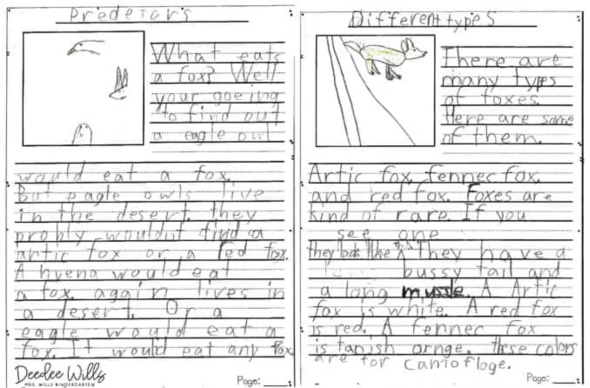
Overview
Second-grade students in SFUSD engage in 120 minutes of daily literacy instruction. Second-grade students engage in a variety of instructional contexts to build foundational skills in reading and writing that provide a strong sense of agency in order to support their identities as readers and writers.

Foundational Skills: During the literacy instruction time students are engaged in a 30-minute of foundational skills instruction that includes phonics, applying those skills in reading and writing, shared reading, and differentiated instruction.

Reading & Writing: There is a 50-minute reading block that includes mini-lessons, differentiated instruction, and interactive read-alouds. Additionally, there is a 40-minute writing block that includes direct, whole group and differentiated instruction. During reading and writing books, students are engaging in reading and writing independently and in partnerships.

Students' vocabulary and knowledge about themselves and their world grow exponentially through regular opportunities to read, think, talk, and write about rich texts around specific topics.
Overview Link to this section
| English Language Arts | 120 Min Daily |
|---|---|
Foundational Skills Block:
| 30 min |
Reading Block:
| 45 min |
| Building Knowledge & Language/Vocabulary | 15 min |
Writing Block:
| 30 min |
Priority Standards Link to this section
What students will know, what students will do, and what thinking skills students will develop to apply and transfer English Language Arts understandings that endure within the discipline, leverage deeper understandings, and/or support readiness for success at the next grade level.
In second grade focus on these critical areas:

Foundational Skills
- Know and apply grade-level phonics and word analysis skills in decoding words.
- Read with sufficient accuracy and fluency to support comprehension.

Reading
- Ask and answer such questions as who, what, where, when, why, and how to demonstrate understanding of key details in a text.
- Identify the main topic of a multi-paragraph text as well as the focus of specific paragraphs within the text.
- Determine the meaning of words and phrases in a text relevant to a grade 2 topic or subject area.
- By the end of the year, read and comprehend literature and informational texts in the grades 2-3 text complexity band (450 - 790 lexile levels) proficiently, with scaffolding as needed at the high end of the range.

Writing
- Write different text types including opinion, narrative, and informative/explanatory aligned with grade-level-specific expectations as defined in the Common Core Standards.
- With guidance and support from adults and peers, focus on a topic and strengthen writing as needed by revising and editing.
- Participate in shared research and writing projects from their experiences and/or gathered information (e.g., read a number of books on a single topic to produce a report; record science observations).
- Respond to texts in writing in order to deepen comprehension
- Demonstrate command of grade-level writing conventions

Speaking & Listening
- Participate in daily collaborative, small-group, or partner discussions about anchor texts to process and extend their learning.
- Engage in productive talk through peer partnerships
- Reflect on each other’s thinking using evidence, as well as consider and challenge each others’ perspectives.
Instruction: Signature Elements Link to this section
Below are signature elements of SFUSD English Language Arts instruction that students should experience regularly throughout second grade as they develop as English readers, writers, speakers, & listeners.
Foundational Skills Routines
These quick routines provide students with time to review and consolidate their phonological knowledge (letter names, sounds, phonemic awareness, high frequency words, etc.)
Phonics Lessons
Phonics instruction is delivered using science-based methods. The methodology includes systematic and explicit instruction aligned with a research-based scope and sequence to provide students with a foundation to become confident, independent readers and writers.
Shared Reading
Shared reading is an interactive experience where teachers model the strategies of proficient readers and children join in the reading as prompted by the teacher. The practice of shared reading allows all children, regardless of reading level, to engage with on-level texts. It also provides children with the tools they need to develop as readers, writers, and critical thinkers as they read a common text together. Additionally, shared reading provides meaningful opportunities for children to construct meaning and revisit a text for different purposes and empowers students to talk about texts.

Differentiated Small Group
As the class engages in activities to build independence, the teacher meets with small groups for targeted instruction based on analysis of student data.
The teacher gathers 2-4 students with similar strengths and needs and leads them in instruction on foundational skills practice, guided reading, or language development. During the lesson, as students are actively engaged in practicing the skill or strategy, the teacher models, monitors understanding, and provides feedback directly to students. The teacher will often follow up the small group instruction with additional lessons as needed.
Reading to Build Knowledge & Read-Aloud
Class communities gather daily to build knowledge in content-rich, grade-level complex texts. Teachers guide students using text-dependent questions and facilitate engaging conversations and written responses that promote evidence-based deeper thinking.
This block may include a variety of instructional contexts, including minilessons, interactive read-aloud, close/shared reading, academic conversations, and writing about text.
Writing Block
During the writing block, students are engaged in creating writing pieces from the Common Core State Standards that follow the writing process. This writing block includes lessons that provide direct, explicit instruction and guided practice in skills and strategies connected to the genre. Afterward, students apply learning to writing in partnerships and individually. There are multiple opportunities for students to share their writing in addition to providing and receiving feedback.

Classroom Libraries to Support Independent Reading
Second-grade classroom libraries provide student access to a range of text types including leveled books, decodable text, informational text, and literature. Libraries should also include culturally relevant texts that represent diverse language and cultures. Leveled books support students' early reading behaviors and print concepts as well as give readers access to reading increasingly complex text. Decodable books reinforce phonics and decoding skills explicitly taught during the foundational skills block.

Informational text and literature provide students access to familiar and/or high-interest books that have been read aloud to students, are connected to content area instruction, or just fun to read. The classroom library should be an inviting space with labeled bins organized by interest, theme, content, level, or phonics skill. The organization of the library should support student engagement and interest along with ease of choice and maintenance.
Literacy Centers
Literacy centers provide students with the opportunity to practice previously taught literacy skills or reinforce content area learning. The centers have appropriate materials to enable students to work independently, with partners or in small groups.
Vocabulary
Students will receive direct instruction in vocabulary words that are connected to the knowledge building topics from read-aloud texts. Academic vocabulary will be reinforced throughout the week with a variety of activities. Students will receive instruction in tools to determine word meaning on their own by applying vocabulary strategies, such as using context and using knowledge of morphology.
Materials
Below are items you should have to support your students' ELA instruction. If you are missing anything from the list, please first contact your site administrator or designated support. If they are unable to resolve the issue promptly, please contact thorntona@sfusd.edu from the SFUSD Elementary ELA Team Team.
HMH Into Reading Physical Resources
- Teacher’s Guides
- Student Materials
HMH Online Resources will be available in Clever after August 15th. If you do not have access, fill out this form to be provided access to the resources.
Modules & Suggested Pacing
Reflection Questions Link to this section
- How are students' developmental needs, communities, and experiences being reflected and honored, or how could they be?
- What opportunities do you see for developing equitable access & demand, inquiry, collaboration, and assessment for learning?
- What are the implications for your own practice? What strengths can you build upon? What will you do first?
Want More?
Standards
- http://www.thecorestandards.org/ELA-Literacy/
- SFUSD ELA Website
Contact the English Language Arts Team:
This page was last updated on August 21, 2024

